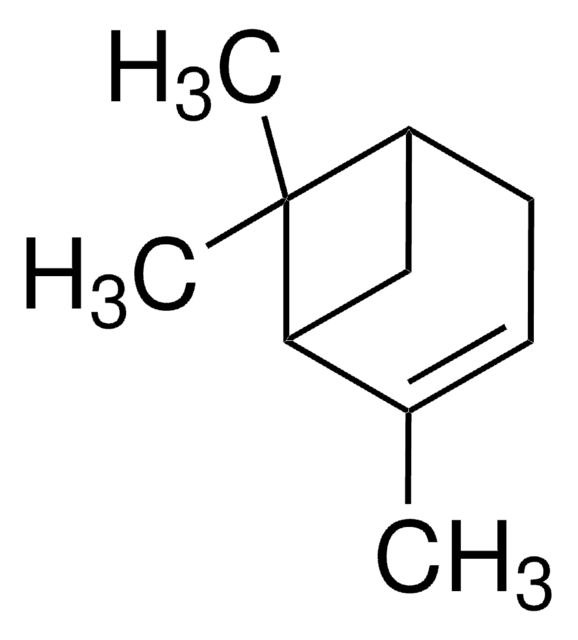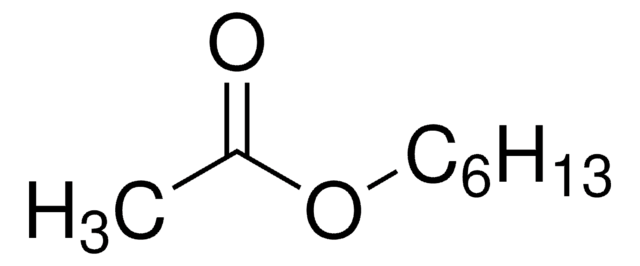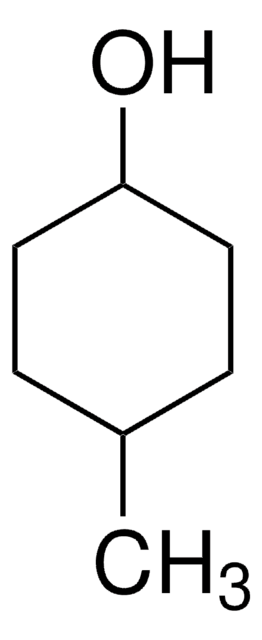112674
Isopentyl acetate
mixture of isomers, reagent grade, 98%
Synonym(s):
Acetic acid 3-methylbutyl ester, Isoamyl acetate
About This Item
Recommended Products
grade
reagent grade
Quality Level
vapor density
4.5 (vs air)
vapor pressure
5 mmHg ( 25 °C)
Assay
98%
form
liquid
autoignition temp.
680 °F
expl. lim.
7.5 %
refractive index
n20/D 1.4 (lit.)
bp
142 °C/756 mmHg (lit.)
mp
−78 °C (lit.)
density
0.876 g/mL at 25 °C (lit.)
SMILES string
CC(C)CCOC(C)=O
InChI
1S/C7H14O2/c1-6(2)4-5-9-7(3)8/h6H,4-5H2,1-3H3
InChI key
MLFHJEHSLIIPHL-UHFFFAOYSA-N
Looking for similar products? Visit Product Comparison Guide
General description
Application
- Development of a safety analysis method for volatile organic compounds using 2-phenoxyethanol as solvent.: This study developed a novel method for analyzing the safety of volatile organic compounds, including Isopentyl acetate, using 2-phenoxyethanol as a solvent. The method enhances the detection and quantification of these compounds in various matrices, which is crucial for ensuring safety standards in industrial applications (Wang et al., 2024).
- Addition of Saccharomyces eubayanus to SCOBY fermentations modulates the chemical and volatile compound profiles in kombucha.: This research demonstrated that introducing Saccharomyces eubayanus to kombucha fermentation alters its chemical and volatile profiles, including an increase in Isopentyl acetate, which impacts the beverage′s aroma and flavor profile (Venegas et al., 2023).
- Honey Bee Colonies (Apis mellifera L.) Perform Orientation Defensiveness That Varies among Bred Lines.: This article explored the behavioral responses of honey bee colonies to different volatile compounds, including Isopentyl acetate, finding variations in orientation defensiveness among different bred lines of bees (Akongte et al., 2023).
- Discovering Aethina tumida responses to attractant and repellent molecules: A potential basis for future management strategies.: The study investigated the responses of Aethina tumida (small hive beetle) to various attractant and repellent molecules, including Isopentyl acetate, which could inform future pest management strategies in apiculture (Roth et al., 2023).
- A Targeted and an Untargeted Metabolomics Approach to the Volatile Aroma Profile of Young ′Martina′ Wines.: This research utilized both targeted and untargeted metabolomics to analyze the aroma profile of young ′Martina′ wines, identifying Isopentyl acetate as a significant contributor to the wine′s volatile profile (Boban et al., 2022).
Signal Word
Warning
Hazard Statements
Precautionary Statements
Hazard Classifications
Flam. Liq. 3
Supplementary Hazards
Storage Class Code
3 - Flammable liquids
WGK
WGK 1
Flash Point(F)
91.4 °F - closed cup
Flash Point(C)
33 °C - closed cup
Certificates of Analysis (COA)
Search for Certificates of Analysis (COA) by entering the products Lot/Batch Number. Lot and Batch Numbers can be found on a product’s label following the words ‘Lot’ or ‘Batch’.
Already Own This Product?
Find documentation for the products that you have recently purchased in the Document Library.
Customers Also Viewed
Our team of scientists has experience in all areas of research including Life Science, Material Science, Chemical Synthesis, Chromatography, Analytical and many others.
Contact Technical Service









